-
 Bitcoin
Bitcoin $106,754.6083
1.33% -
 Ethereum
Ethereum $2,625.8249
3.80% -
 Tether USDt
Tether USDt $1.0001
-0.03% -
 XRP
XRP $2.1891
1.67% -
 BNB
BNB $654.5220
0.66% -
 Solana
Solana $156.9428
7.28% -
 USDC
USDC $0.9998
0.00% -
 Dogecoin
Dogecoin $0.1780
1.14% -
 TRON
TRON $0.2706
-0.16% -
 Cardano
Cardano $0.6470
2.77% -
 Hyperliquid
Hyperliquid $44.6467
10.24% -
 Sui
Sui $3.1128
3.86% -
 Bitcoin Cash
Bitcoin Cash $455.7646
3.00% -
 Chainlink
Chainlink $13.6858
4.08% -
 UNUS SED LEO
UNUS SED LEO $9.2682
0.21% -
 Avalanche
Avalanche $19.7433
3.79% -
 Stellar
Stellar $0.2616
1.64% -
 Toncoin
Toncoin $3.0222
2.19% -
 Shiba Inu
Shiba Inu $0.0...01220
1.49% -
 Hedera
Hedera $0.1580
2.75% -
 Litecoin
Litecoin $87.4964
2.29% -
 Polkadot
Polkadot $3.8958
3.05% -
 Ethena USDe
Ethena USDe $1.0000
-0.04% -
 Monero
Monero $317.2263
0.26% -
 Bitget Token
Bitget Token $4.5985
1.68% -
 Dai
Dai $0.9999
0.00% -
 Pepe
Pepe $0.0...01140
2.44% -
 Uniswap
Uniswap $7.6065
5.29% -
 Pi
Pi $0.6042
-2.00% -
 Aave
Aave $289.6343
6.02%
Will WR rebound after hitting the bottom three times in a row? What is the probability?
When the Williams %R hits -100 three times consecutively in crypto, it may signal oversold exhaustion, but a rebound isn't guaranteed without confirming factors like volume, trend, and price action.
Jun 15, 2025 at 09:49 pm
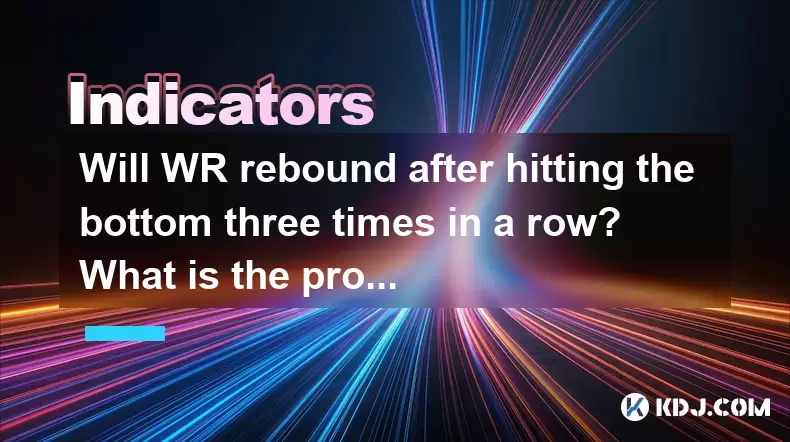
Understanding the WR Indicator in Cryptocurrency Trading
The Williams %R (WR) is a momentum oscillator used by traders to identify overbought or oversold conditions in an asset. It ranges from 0 to -100, where readings above -20 suggest overbought levels and below -80 indicate oversold levels. In the context of cryptocurrency trading, the WR indicator can be particularly volatile due to the high fluctuations typical in digital assets.
When a trader observes that the WR has hit the bottom (-100) three times consecutively, it raises questions about whether a rebound is likely. This situation may signal strong bearish pressure followed by potential exhaustion of selling momentum. However, interpreting such signals requires careful analysis within the broader market context.
Important Note: The WR indicator alone should not be used as a standalone tool for making trading decisions, especially in fast-moving markets like crypto.
Historical Patterns: What Does It Mean When WR Hits the Bottom Three Times?
In technical analysis, repeated visits to extreme levels on oscillators like the WR often reflect ongoing market sentiment. If the WR touches -100 three times in a row, this could mean that each time the price tried to move lower, it triggered short-term oversold conditions but failed to reverse immediately.
This pattern might suggest:
- Consistent downward pressure
- Repeated rejection at support levels
- Accumulation or distribution phases
However, the key question remains: does this repetition increase the probability of a rebound?
To answer this, historical data must be reviewed across multiple crypto assets and timeframes. For example, analyzing Bitcoin, Ethereum, and altcoins during different market cycles can provide insight into how frequently such patterns precede reversals.
Factors Influencing the Probability of a Rebound
Several variables affect the likelihood of a rebound after the WR hits the bottom three times:
- Market Trend: A downtrend may suppress rebounds even after multiple WR bottoms.
- Volume: Rising volume during the third touch might indicate increased interest and hint at a reversal.
- Price Action: Bullish candlestick patterns forming near the third WR bottom can enhance the probability of a bounce.
- Timeframe: Shorter timeframes (like 1-hour charts) are more prone to false signals compared to daily or weekly charts.
- Correlation with Broader Market: If the entire crypto market is in a sell-off, individual asset rebounds are less likely.
Therefore, while the WR hitting the bottom thrice might seem like a strong signal, its effectiveness depends heavily on these external factors.
Analyzing Real Chart Examples in Crypto Markets
Let’s take a look at how this scenario played out in real cryptocurrency charts:
On the BTC/USDT daily chart, there were instances in late 2022 where the WR reached -100 three times within a month. Each time, the price briefly bounced but continued lower due to macroeconomic pressures and a bearish trend.
Conversely, on the ETH/USDT 4-hour chart during early 2023, the WR hit -100 three times, followed by a strong bullish engulfing candle and a subsequent rally of over 15%.
These examples show that while the pattern isn’t foolproof, it can offer clues when combined with other indicators and price action analysis.
How to Calculate the Probability of a Rebound After Triple WR Bottoms
To estimate the probability of a rebound, traders can backtest historical data using tools like TradingView or Python scripts with libraries such as Pandas and TA-Lib. Here's how you can do it step-by-step:
- Step 1: Define what constitutes a "bottom" — typically, a WR reading of -100 or very close to it.
- Step 2: Scan the historical data for sequences where WR hits the bottom three times in a row.
- Step 3: Record the price movement 5–10 candles after the third bottom.
- Step 4: Count how many times a rebound occurred (e.g., price rises by at least 2%).
- Step 5: Divide successful rebounds by total occurrences to calculate the probability.
For instance, if out of 50 cases, 30 led to a rebound within five candles, the probability would be 60%. This number varies across assets and timeframes.
Combining WR with Other Indicators for Better Accuracy
Using the WR in isolation can lead to misleading signals. To improve accuracy, consider combining it with:
- Moving Averages: Look for crossovers or price interaction with key moving averages like the 50-day or 200-day SMA.
- RSI Divergence: If RSI forms higher lows while price makes lower lows, it suggests hidden strength.
- Volume Profile: Increasing volume during the third WR bottom may confirm accumulation.
- Fibonacci Retracements: Check if the price is near major Fibonacci support levels.
By layering these tools, traders can filter out false signals and better assess the true probability of a rebound.
Frequently Asked Questions
Q1: Can WR hitting the bottom three times be used as a buy signal?
A: While it may indicate oversold conditions, it should not be used alone. Confirm with other indicators and price structure before considering a buy.
Q2: Is the WR more reliable on certain cryptocurrencies?
A: WR tends to perform better on larger-cap cryptos like BTC and ETH due to their relatively stable volume and reduced manipulation risk compared to small-cap altcoins.
Q3: How long should I wait after the third WR bottom to see a rebound?
A: Most rebounds occur within 5–10 candles on intraday charts, though longer timeframes may require more patience.
Q4: Should I use the default WR settings or adjust them for crypto trading?
A: The default period is 14, but many traders tweak it to 7 or 21 depending on strategy and volatility. Testing different settings via backtesting is recommended.
Disclaimer:info@kdj.com
The information provided is not trading advice. kdj.com does not assume any responsibility for any investments made based on the information provided in this article. Cryptocurrencies are highly volatile and it is highly recommended that you invest with caution after thorough research!
If you believe that the content used on this website infringes your copyright, please contact us immediately (info@kdj.com) and we will delete it promptly.
- 2025-W Uncirculated American Gold Eagle and Dr. Vera Rubin Quarter Mark New Products
- 2025-06-13 06:25:13
- Ruvi AI (RVU) Leverages Blockchain and Artificial Intelligence to Disrupt Marketing, Entertainment, and Finance
- 2025-06-13 07:05:12
- H100 Group AB Raises 101 Million SEK (Approximately $10.6 Million) to Bolster Bitcoin Reserves
- 2025-06-13 06:25:13
- Galaxy Digital CEO Mike Novogratz Says Bitcoin Will Replace Gold and Go to $1,000,000
- 2025-06-13 06:45:13
- Trust Wallet Token (TWT) Price Drops 5.7% as RWA Integration Plans Ignite Excitement
- 2025-06-13 06:45:13
- Ethereum (ETH) Is in the Second Phase of a Three-Stage Market Cycle
- 2025-06-13 07:25:13
Related knowledge

How to set the stop profit point after the high-level propeller pattern?
Jun 16,2025 at 08:04pm
Understanding the High-Level Propeller PatternThe high-level propeller pattern is a technical analysis formation often observed in cryptocurrency trading charts. It typically appears at significant price peaks and signals potential reversals. The pattern consists of a large candlestick with long upper and lower shadows, resembling a propeller, indicatin...

When is the most reasonable stop loss after the three crows pattern?
Jun 16,2025 at 08:14pm
Understanding the Three Crows Pattern in Cryptocurrency TradingThe three crows pattern is a well-known bearish reversal signal in technical analysis, particularly relevant in volatile markets like cryptocurrency. It typically appears at the end of an uptrend and consists of three consecutive long red (or bearish) candles with progressively lower closes....
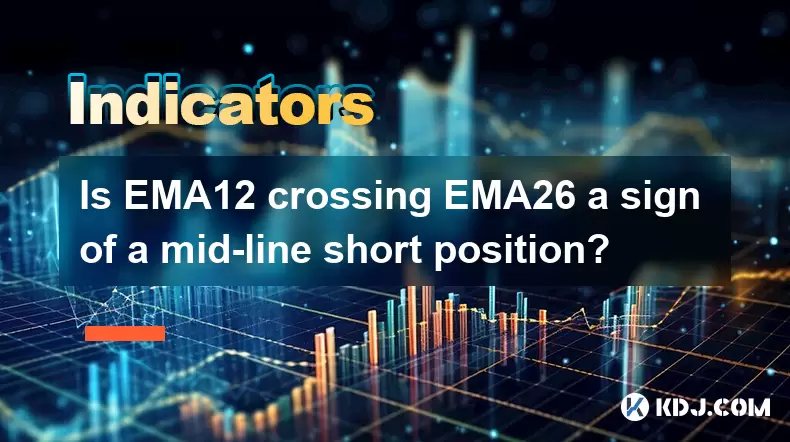
Is EMA12 crossing EMA26 a sign of a mid-line short position?
Jun 16,2025 at 07:22pm
Understanding EMA12 and EMA26 in Cryptocurrency TradingIn the world of cryptocurrency trading, Exponential Moving Averages (EMAs) are widely used tools for analyzing price trends. Specifically, the EMA12 and EMA26 are two of the most commonly referenced EMAs among traders. The EMA12 represents a short-term moving average calculated over the past 12 time...
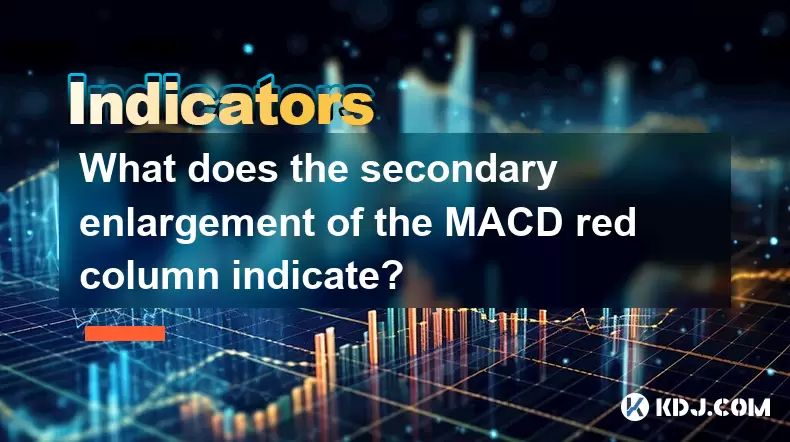
What does the secondary enlargement of the MACD red column indicate?
Jun 16,2025 at 07:49pm
Understanding the MACD Indicator and Its ComponentsThe Moving Average Convergence Divergence (MACD) is a widely used technical analysis tool in cryptocurrency trading. It consists of three main components: the MACD line, the signal line, and the MACD histogram. The histogram, represented as red or green bars, reflects the difference between the MACD lin...
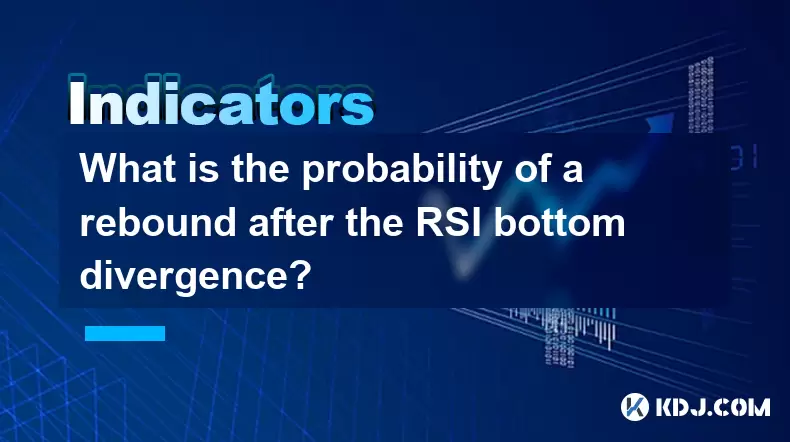
What is the probability of a rebound after the RSI bottom divergence?
Jun 16,2025 at 06:50pm
Understanding RSI Bottom Divergence in Cryptocurrency TradingThe Relative Strength Index (RSI) is a widely used momentum oscillator in technical analysis, particularly within the cryptocurrency market. It helps traders identify overbought or oversold conditions and potential reversal points. A bottom divergence occurs when the price of an asset makes a ...
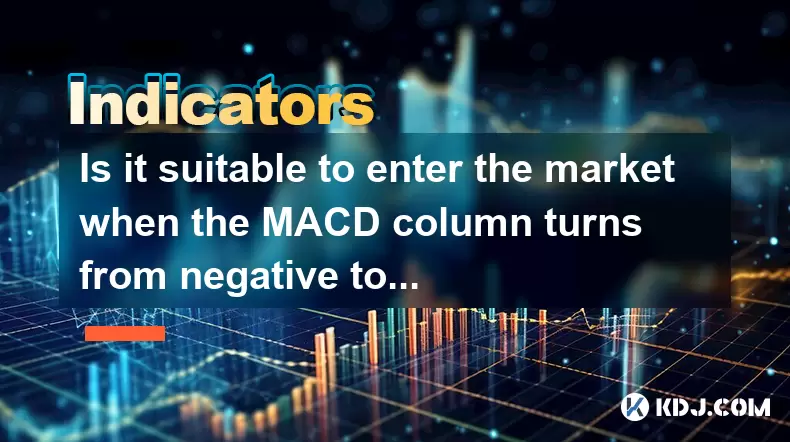
Is it suitable to enter the market when the MACD column turns from negative to positive?
Jun 16,2025 at 06:07pm
Understanding the MACD IndicatorThe Moving Average Convergence Divergence (MACD) is a widely used technical analysis tool in cryptocurrency trading. It consists of three main components: the MACD line, the signal line, and the MACD histogram (often referred to as the MACD column). The MACD line is calculated by subtracting the 26-period Exponential Movi...

How to set the stop profit point after the high-level propeller pattern?
Jun 16,2025 at 08:04pm
Understanding the High-Level Propeller PatternThe high-level propeller pattern is a technical analysis formation often observed in cryptocurrency trading charts. It typically appears at significant price peaks and signals potential reversals. The pattern consists of a large candlestick with long upper and lower shadows, resembling a propeller, indicatin...

When is the most reasonable stop loss after the three crows pattern?
Jun 16,2025 at 08:14pm
Understanding the Three Crows Pattern in Cryptocurrency TradingThe three crows pattern is a well-known bearish reversal signal in technical analysis, particularly relevant in volatile markets like cryptocurrency. It typically appears at the end of an uptrend and consists of three consecutive long red (or bearish) candles with progressively lower closes....

Is EMA12 crossing EMA26 a sign of a mid-line short position?
Jun 16,2025 at 07:22pm
Understanding EMA12 and EMA26 in Cryptocurrency TradingIn the world of cryptocurrency trading, Exponential Moving Averages (EMAs) are widely used tools for analyzing price trends. Specifically, the EMA12 and EMA26 are two of the most commonly referenced EMAs among traders. The EMA12 represents a short-term moving average calculated over the past 12 time...

What does the secondary enlargement of the MACD red column indicate?
Jun 16,2025 at 07:49pm
Understanding the MACD Indicator and Its ComponentsThe Moving Average Convergence Divergence (MACD) is a widely used technical analysis tool in cryptocurrency trading. It consists of three main components: the MACD line, the signal line, and the MACD histogram. The histogram, represented as red or green bars, reflects the difference between the MACD lin...

What is the probability of a rebound after the RSI bottom divergence?
Jun 16,2025 at 06:50pm
Understanding RSI Bottom Divergence in Cryptocurrency TradingThe Relative Strength Index (RSI) is a widely used momentum oscillator in technical analysis, particularly within the cryptocurrency market. It helps traders identify overbought or oversold conditions and potential reversal points. A bottom divergence occurs when the price of an asset makes a ...

Is it suitable to enter the market when the MACD column turns from negative to positive?
Jun 16,2025 at 06:07pm
Understanding the MACD IndicatorThe Moving Average Convergence Divergence (MACD) is a widely used technical analysis tool in cryptocurrency trading. It consists of three main components: the MACD line, the signal line, and the MACD histogram (often referred to as the MACD column). The MACD line is calculated by subtracting the 26-period Exponential Movi...
See all articles

























































































